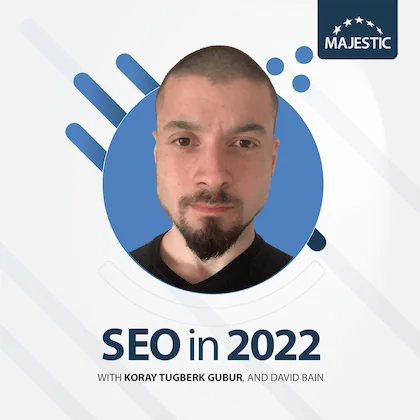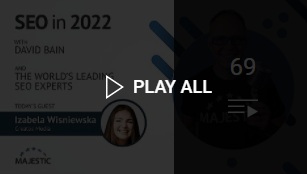-
Site Explorer
- Majestic
- Summary
- Ref Domains
- Backlinks
 New
New Lost
Lost- Context
- Anchor Text
- Pages
- Topics
- Link Graph
- Related Sites
- Advanced Tools
- Author ExplorerBeta
- Summary
- Similar Profiles
- Profile Backlinks
- Attributions
- Compare
-
Link Tools
- My Majestic
- Recent Activity
- Reports
- Campaigns
- Verified Domains
- OpenApps
- API Keys
- Keywords
- Keyword Generator
- Keyword Checker
- Search Explorer
- Link Tools
- Bulk Backlinks
- Neighbourhood Checker
- Submit URLs
- Experimental
- Index Merger
- Link Profile Fight
- Mutual Links
- Solo Links
- PDF Report
- Typo Domain
- Free SEO Tools
-
Support
- Blog

- Support
- Get started
- Tools
- Subscriptions & Billing
- FAQs
- Glossary
- How To Videos
- API Reference Guide

- Contact Us
- About Backlinks and SEO
- SEO in 2024
- Link Building Guides
- Webinars
- Blog
Focus on semantic SEO and natural language processing
Koray Tuğberk GÜBÜR
For Koray, we've already got to a point where we can trust the machines to be producing at least some of the content for us.

Focus on semantic SEO and natural language processing
Koray says: "Natural language generation is a new concept that basically means generating text through AI, and the next step of this will be natural language optimization. At the moment, a lot of people are using the GPT-3 model for natural language generation. GPT-3 is an AI that is able to generate highly convincing text, and incorporate keywords into the copy. However, as more of the text online is becoming automatically generated, it will decrease the quality threshold for search engines - because the web will become more bloated. 70% of the content on the web in the last three years has been generated by AI, and this percentage will only increase in the future. Because of this, semantics is becoming even more important in content creation. You need to be giving clear context, using clear sentence structure, and communicating the relationships between entities using attributes."
How does an SEO add meaning to their content? Are you suggesting that they use AI to generate more content?
"I would suggest using our own brains first, because any kind of tool can prevent you from learning about semantic SEO (SEO with meaning built into the words used in content). Projecting meaning, creating a contextual vector, or giving a contextual relevance between entities, can't be done naturally, because we are also semantic creatures. I suggest that every SEO creates proper content briefs for the authors first. Then, they can start to perform tests for question generation, answers matching that question, and fact extraction. There are a lot of algorithms you can use, like RoBERTa or BERT, or data sets and free language models for text generation, at the moment."
Do you think AI is at a stage where it can produce the type of content that users will love and think a real human being has written it?
"Yes. It might not be perfect, but in the near future - maybe one or two years - it will get better and better. I still believe there will be a human need for organising the content. If you don't create proper parameters in your function, and if you don't use your parameters in a proper way, AI might also generate irrelevant text. They might not know some answers like humans do, especially when it comes to reviewing a reviewable entity - sometimes it is a product, sometimes it is a kind of service. AI might be biased, based on language, the data set they use, or on the human feedback. I believe there will always be a need for human assistance. Soon the content writers could be the assistants for AI, and they will use AI for generating more text."
Is Google getting better at understanding the context of everything that's written on a webpage?
"Definitely. Google have announced two different algorithms, MUM and LaMDA, and they also have some other language models they didn't announce, like SMITH, KELM and REALM. Since they are able to understand human language in a much better way, they have started to explore new contexts - the contexts that are not answered yet. That's why they also created the Question Hub that has been integrated into the Google Search Console because there are lots of questions that are not answered yet. The other thing is that some questions are not answered in different languages - so they're trying to make all of the information accessible for all the languages.
When it comes to semantic SEO, people should focus on the concepts and the meanings, not the phrases or the languages. If you focus on one language, you will just get that entity's one-sided feature or profile. Search engines gather their information from all geographies, audiences, and languages. If you unite this information, you will be able to understand a concept in a better way. This view leads to a second phase, which is the search activity, or search behaviour, of the users. When you start to understand them in a better way, it means there will be a lot of different contextual layers. You can use variable portions in the questions to explore these new contexts. There are lots of different subtopics in every area, and at the moment, they are starting to organise all of these contextual domains with an idea."
What does this mean for keyword research - is it still relevant in 2022?
"It is, but it's about how we use it. To be honest, I don't use it for my content briefs, I usually use it for improving relevance. When it comes to semantic SEO, using synonyms, or different variations of a phrase, is important. Let's say we have a query with two million documents with different levels of relevance. When you have millions of documents for a query, you will see different types of co-occurrence matrices, and you will start to realise there is a query document template, and different types of pure clusters.
Once you're able to extract entities and concepts, you will start to realise there is a user behaviour pattern. When you extract all of these themes, it will start to be about actual entities, concepts, interest areas, or search behaviours, more than keywords. You can still use keywords but try to use them to improve relevance, instead of creating the content brief. If you want to create a content brief that can rank in Google SERP, you should use these types of connections based on entities, attributes, semantic role labelling, or lexical relations - there are lots of other terms that can be used."
If an SEO was responsible for creating this content brief for each new article on the website, how do they decide the length, and what needs to be included in the content, to deliver the ultimate answer to the question being asked?
"When it comes to creating a content brief, you should try to understand the prominent attributes of an entity. Semantic search engines will start to parse entities, and their queries, and recognise that there are some attributes. These attributes are mutual for some certain types of entities. For instance, countries have capitals, presidents, regimes, populations, and currencies. These are the root attributes. Based on your question, and your source's context, everything can change.
Let me give you an example from Google's MUM announcement. If you search for 'hiking mountain Fuji', they will start to give your possible contexts there. If you ask me, there are three main contexts. One is hiking on Mount Fuji. The second is hiking. And the third is hiking on a mountain. Based on your source's context, you will need to create different types of topical maps and content groups. If it's about hiking mountains, you will need to include all the mountains in Asia or Europe. If it's just hiking, it will include all sorts, like, hiking books, backpacks, shoes, podcasts, and tips. If it is about Mount Fuji, the context will be entirely different, as will your topical maps and content groups. When it comes to creating a design, it's actually about your topical map and your source's context."
Does this work equally well for product pages, when you just want to talk about something very specific that you're selling?
"It definitely works. When it comes to SEO semantics, it's not just about one type of content. At the moment search engines are SEO semantic. For products, the search engine creates a line of products and related brands. When it comes to reviewing or explaining how to use a product, these types of questions can be used in the content section. When I try to create content for a product, I usually check off the popular eCommerce sites because I can extract dimensions and attributes for the product from there. Furthermore, I can extract angry rants from the reviews themselves. All of this product information can be used within the product page.
ECommerce SEO should also be about the layout of the webpage, as well as reviews and product explanations. This should also be included within the semantic SEO, because Google talks about how meaning can change based on the layout of the webpage. If a product page doesn't have a proper order, or placement of components, the context can be shifted - even if the content is perfect."
What's one thing that SEOs can stop doing to focus more time on semantic SEO?
"I see lots of SEOs who add random leads into content. They usually add internal links for the sake of adding them and think: 'the more, the better'. They use links just for referencing other pages, so that search engines will think it is endorsed and reliable content that can be related to its sources. I suggest you stop doing this.
If you want to use internal links, create a contextual bridge between two pages - internal links should have relevance between two pages. They need to have a connection. Try to use your internal links within the main content, and do not add extra links just for the sake of it. Also, only link to other sources if it makes sense. Be very careful about this too. If you link to an external website that mentions or links to your competitor, you might end up losing your competitor in an indirect way. Majestic's Link Graph can really help with this, as they will show you the millions of indirect links within the pages."
You can find Koray Tuğberk GÜBÜR over at HolisticSEO.digital.
Choose Your Own Learning Style
 Video
Video
If you like to get up-close with your favourite SEO experts, these one-to-one interviews might just be for you.
Watch all of our episodes, FREE, on our dedicated SEO in 2022 playlist.
 Podcast
Podcast
Maybe you are more of a listener than a watcher, or prefer to learn while you commute.
SEO in 2022 is available now via all the usual podcast platforms
Don't miss out
Opt-in to receive email updates.
It's the fastest way to find out more about SEO in 2025.
Could we improve this page for you? Please tell us





